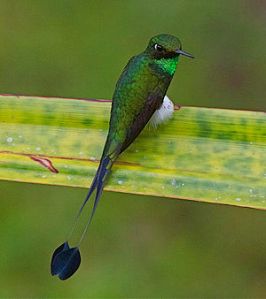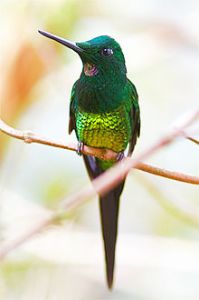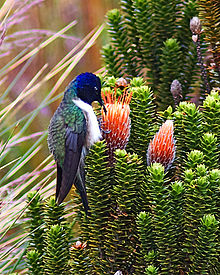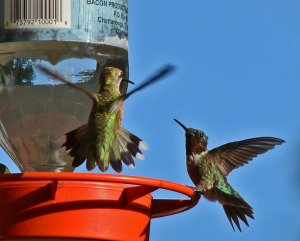We are lucky to have a number of people in our area who are extremely knowledgeable birders. Monday night, our Bird Club featured a speaker who gave a fascinating talk and slideshow about hummingbirds. The speaker was none other than Virginia’s own birdman extraordinaire, Dr. John Spahr. He has traveled the world in hot pursuit of his avian passion.
I learned that there are over 330 species of hummingbirds – all located in the Americas, from Alaska all the way down to the end of South America. There are no hummingbirds in Europe, Africa, or Asia (sorry). The largest number of hummingbird species (150+) are found in the small South American country of Ecuador.
Dr. Spahr showed us pictures of the most exotic-looking birds I never knew existed with impossible names such as Green Violetear, Long-tailed Sylph, Booted Racket-Tail, Spangled Coquette and Red Saberwing.
Can you imagine a punk-rock bird with a red mohawk, another one with a beak longer than its body, and one with white cotton balls around its feet? Yup, I am not making this up, I saw the pictures. And it’s always the males who are the most flamboyant, as if some painter designed them while under the influence of some hallucinatory drug.
Here, in Virginia, we have exactly one representative from the Trochilidae (Hummingbird) family: the Ruby-Throated Hummingbird, named after the red patch on the male’s throat. The ruby throats mate and produce offspring (usually two) during the warmer months before migrating South for the winter. Every once in a while, an errant Anna’s Hummingbird or a Rufous Hummingbird might come through in late fall or even winter. These Western birds should be migrating to Mexico but sometimes find their way East instead. Here are two of “our” ruby throats: a male on the right (with red throat patch) and a female (with a whitish throat).
You often hear a hummingbird first, before you see them. They sound like a large droning insect with their wings flapping up to 200 times per second. Hummingbirds have an “elbow” joint in their wing that is a ball-and-socket joint and allows them to fly backwards and upside down as needed. In slow motion, you can see their wings perform a figure-eight pattern instead of an up and down motion.
Because of their rapid metabolism, hummers have to consume more than their body weight in nectar in one hour. So if a bird weighs 3 grams, it may have to consume close to 4 grams every hour, over 40 grams a day, or the equivalent of sipping 1000 to 2000 flowers each day.
Dr. Spahr also talked about the difference between the sugar water in the feeder and flower nectar. The birds get about 10 calories per feeding from the sugar water, but they get 30 calories per feeding from a flower. Flower nectar also provides electrolytes and small amounts of protein. He advised us not to buy the red-colored sugar solution that is commercially available. The home-made version (1 part sugar to 3 parts water, heated to dissolve the sugar, then cooled) is superior to the colored commercial product.
The hummingbirds’ attractive, iridescent colors are derived, not from pigment on the feathers, but from the feather structure itself. This is why the throat color (also called gorget) of a ruby-throated male can appear black, red, or orange. The following pictures show various levels of red and orange coloring depending on head position and light reflection. I also included an immature male with only some dots of throat coloring which will turn into the full-fledged gorget as he matures into adulthood.
I am hoping that our hummingbird feeders are helping these birds reduce their level of exertion, especially now as they are preparing for migration. They will fly South to the Gulf States. From there, and after doubling their liver size through glucose storage, they cross 500 miles of open ocean to overwinter in Mexico or another Latin American country. If they are lucky, they might rest a few moments on a cruise ship or oil rig.
The first three hummingbird pictures were taken from a Wikipedia site. All the pictures of the Ruby-Throated Hummingbirds are mine. You can see more pictures of exotic hummingbirds on this Wikipedia link.















This is a great post, very informative plus all the terrific shots of the birds in your yard. We have several feeders ourselves (by the way, where did you get that upside-down bottle style?) and take great delight in watching them. Fortunately, we have the sugar/water formula going but based on your revelation that flowers are 3X better, we had best pick up our game in that area. Thanks for the post.
LikeLike
Hi Robin – thanks for reading and commenting. The upside-down feeder is at a friend’s house. It may be a home-made version. This is a good time to increase the sugar in the water a bit since they need to store additional glucose. You can even keep up the feeders into the winter just in case there are some stragglers.
LikeLike
Absolutely lovely!
LikeLike
Thanks, Diana. Buena suerte with your feeding adventure 🙂
LikeLike
Really great post with lovely images. thank you sharing all these interesting facts. 🙂
LikeLike
Hi Amanda – thank you for visiting and taking the time to comment. Glad you enjoyed the post.
LikeLike
These were so gorgeous. Growing up we had a bird feeder near our kitchen window, and my parents left a book of birds so we could look them up as they flew near. But, in NJ we don’t have these extraordinary birds.
I often thought I’d love to bird watch – but I don’t know the first thing about it!
Thanks for bringing this to my attention. These are incredibly beautiful birds. I never knew about them! I love your photos. You must be a wonderful photographer!
LikeLike
Hi Cathy – you don’t need any experience to watch birds. Just do it, then start looking them up in a bird ID book. Bit by bit, you’ll learn more. Each spring, I greet them like old friends – oh, look, the first Robin! Oh, there’s a glint of yellow in the grass, that’s Meadowlark. They are beautiful to watch but also an integral part of our eco-system to protect. Thanks for visiting and commenting.
LikeLike
Outstanding photos, Annette. Question for you. I got rid of my hummingbird feeders a few years ago because of bees. I have lots of salvia, lantana, sage which the hummingbirds love. Do you think that’s enough for them? I only have two or three hummers regularly visiting the garden.
LikeLike
Hi Barbara, there’s a way to insert a small plastic container between the hook and the feeder, fill it with water, so the ants can’t get to the feeder. It’s harder to describe than it actually is to do….you’ll see a lot more hummingbirds when you put up a feeder especially now, just before migration…
LikeLike
Wow! No hummers in Europe, Africa, or Asia? I had no idea. In Nicaragua, it is impossible to find hummingbird feeders and hummer food. I make my own food following your recipe and put the excess in the refrigerator. Thank goodness we always have a variety of flowers blooming for the electrolytes and protein. I’m wondering what I can add to the sugar water to give them electrolytes? I’ll have to do some more research. Thanks, Annette. This post is fascinating.
LikeLike
Hi Debbie – you probably don’t have to worry about finding a source of electrolytes. In the tropical regions, there’s always something in bloom year-round, so the hummers get their nutrition; but it is a good question. “Gatorade” supposedly adds electrolytes but I won’t put that in my own body, far less offer it to a hummingbird….:-)
LikeLike
Fascinating post! We love to watch all kinds of birds here in the UK. Swallows are probably are our best known migrant birds. We watch for them arriving in Spring and then look out for them gathering on the telephone wires in their groups in September, ready to fly back to Africa. Migration over such vast distances is certainly one of nature’s wonders.
LikeLike
Thank you, Peggy. Yes, I am also very intrigued by this whole migration piece. How do the birds orient themselves, how do they know where to go and when they have gone far enough and then the whole process in reverse. Totally mysterious – universal intelligence at work.
LikeLike
Their genetic GPS is certainly impressive 🙂
LikeLike
Lovely post Annette. I see humming birds every day from the window of my little home office, before I see them I can hear their sounds. They have become little sweet friends to me.
LikeLike
If you are in California, you are probably seeing Anna’s and Rufous Hummingbirds? so glad you get to enjoy these little creatures…
LikeLike
Thank you Annette, I have to research on the kind of hummy’s visiting me.
LikeLike
How lovely to have these beautiful birds in your yard, Annette! I see that there are three species of these birds in Florida, and I intend to buy some feeders to see if I can attract some to my backyard. I read that one also needs to plant, red, pink and orange flowers in the garden. Gorgeous pics. 🙂
LikeLike
Flowers are always a superior food source and delightful to the human eye, as well. But feeders have their place as well. Hope you’ll have a lot of fun getting settled into your new home in Florida.
LikeLike
So lovely, as usual. I spotted a hummingbird hovering in our shrubbery the other day. Too late for a snap. I am delighted to find pics here–especially of our Virginia treasures.
LikeLike
They are fast! It takes a lot of patience and “camping out” to get decent hummer photos. Ask me how I know 🙂
LikeLike
I recently saw humming birds, when I was visiting a friend since she had a special feeder for them. They did not stay still for a second, so I find your pictures: “work of art”. Maybe you can have another post that will tell us how? to take pictures of these fast birds.
Thank you Annette!
LikeLike
If you have a “sports” setting (for fast action) on your camera, that’s the setting to use. The regular settings are too slow. Also, when you click a dozen pics at once (thru the sports setting), you are likely to get one that’s decent and hopefully not blurred. I am sure there are photo experts who can accomplish this with manual settings, a tripod, special shutter speeds, etc. but I’m not that kind of a photographer 🙂 (yet).
LikeLiked by 1 person
I enjoyed the photos. Your efforts without all the hi-tech stuff are commendable. Thanks for these tips. 🙂
LikeLike
Those photos are amazing!!! I really enjoyed them. Thank you for this post and the beautiful photos.
LikeLike
Thanks for checking it out, Laura. I spent a lot of time last summer trying to get decent shots, they are so fast and skittish….
LikeLike
You’re welcome. Your efforts were well worth it!
LikeLiked by 1 person
Pingback: Safely Enveloped: Hummer Rescue | The Beauty Along the Road
Beauty,
This is a very nicely written article! I really envy those who have seen those South and Central American hummingbirds.
We have gotten one sighting of three Ruby-Throats this summer (in the mountains of BC, Canada) and an even more incredible recent sighting of a Magnificent Hummingbird in the BC interior. This would be the equivalent of seeing the Xantus hummingbird in Gibsons, BC, in 1997!
http://bcbirdalert.blogspot.ca/2015/07/magnificent-hummingbird-relocated-in.html
http://bcbirdalert.blogspot.ca/2015/07/magnificent-hummingbird-north-of.html
Cheers,
Hui
LikeLiked by 1 person
Seriously – a Magnificent Hummingbird – I thought we only had the ruby-throat, Rufous and Anna’s in N. America.
LikeLiked by 1 person
For a very long time, that was my preconception, too. apparently North America is home some seventeen species, including Costa’s, Calliopes, Black-Chinned, Allen’s, and Broad-Tail Hummingbirds.
The Magnificent is primarily seen in Arizona and Mexico. For it to be even seen up here represents the most northward this species has ever made it!
LikeLike
As global warming continues, we may see more surprises in the future…
LikeLike
indeed. apparently it was snowing in Hawaii yesterday!
http://www.hawaiinewsnow.com/story/29573757/snow-falls-on-mauna-kea-summit-in-july
LikeLike
Seems counter-intuitive, doesn’t it – but all part of the great climate chaos that’s happening.
LikeLiked by 1 person
and speaking of climate change, with the drought that Vancouver has been experiencing for the past three months, you won’t know that we ever had a reputation as the Wet Coast.
LikeLike
I live in the mountains of Virginia and about a month ago, our air was unusually hazy for several days. I thought that there must have been a controlled burn somewhere nearby, but turned out it was smoke from the Canadian wild fires that got carried all the way into our area….Wished I could send some of the rain up your way. We’ve had about 50 days of rainy weather and just now getting real summer weather again.
LikeLiked by 1 person
I remember waking up to the day of those forest wildfires … the sky had a hazy red tint to it, and the sun was also red, and I wondered for a moment if I had woken up at sunset instead of sunrise.
it was so bad that a severe air advisory were issued, and for three days the smoke hung around. it was recommended that people not engage in any exercise or other forms of strenuous activities!!
lawn watering has recently been reduced from three days to one, and campfires have been banned too. I’ll take some of your rain, please!! 🙂
LikeLiked by 1 person
Pingback: Summer Pleasures – Watching Hummingbirds | The Beauty Along the Road
such an amazing species. thank you for the lovely post. going back to read and view again.
LikeLiked by 1 person
Yes, they are such beautiful and interesting little creatures. Glad you enjoyed the post. If you are interested in more of the hummer posts, you can put “hummingbird” in the search function and find them. Thank you so much for stopping by and commenting.
LikeLiked by 1 person
thank you and I will do that.
LikeLike
You might enjoy this post which is one of the most popular posts on my blog: https://beautyalongtheroad.wordpress.com/2015/05/17/safely-enveloped-hummer-rescue/
LikeLiked by 1 person
awesome. thank you for being so thoughtful and kind. going there now…..
LikeLiked by 1 person